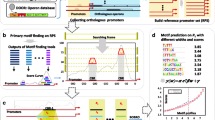Abstract
The comparative analysis of motifs of promoter sequences of the genes encoding enzymes of metabolic pathways such as glycolysis and kreb cycle in different genomes can give insights into the understanding of evolutionary and organizational relationships among both the species as well as enzymes. The comparison of resulting analysis with those of the evolutionary distances drawn considering coding regions of the genes allows one to measure the evolution of complete processes. In the present study we have collected promoter sequences of the glycolysis and kreb cycle genes encoding the respective enzymes from the standard EMBL database and extracted ten Transcription factors (TFs) using the TFsearch tool. This information was put together to develop a database CMPP database both offline and online (http://cmpp.sbbiotech.com). The matrix was developed by calculating the distances based on the presence or absence of motifs (TFs). The phylogenetic tree was obtained by using the NJ method by calculating the distances both within and between the enzymes of glycolysis and kreb cycle individually. The present study could also be extended to pathways such as carbohydrate and lipid metabolic networks.
Similar content being viewed by others
References
Blanco, E., Messeguer, X., Smith, T.F., Guigo, R. 2006. Transcription factor map alignment of promoter regions. PloS Computa Biol 2, 403–416.
Bucher, P. 1999. Regulatory elements and expression profiles. Curr Opin Struct Biol 9, 400–407.
Devos, K. M., Gale, M.D. 2000. Genome Relationships: The Grass Model in Current Research. Plant Cell 12, 637–646.
Ficket, J.W., Hatzigeorgiou. 1997. Eukaryotic promoter recognition. Genome Res 7, 861–878.
Forst, C.V., Schulten, K. 2001. Phylogenetic analysis of metabolic pathways. Journal of Molecular Evolution 52, 471–489.
Forst, C.V., Schulten, K. 1999. Evolution of metabolisms: A new method for the comparison of metabolic pathways using genomic information. Journal of Computational Biology 6, 343–360.
Frank, O. Phylogenetic tree computation tutorial, http://pga.lbl.gov/Workshop/April2002/lectures/Olken.pdf.
Gielly, L., Taberlet, P. 1994. The use of chloroplast DNA to resolve plant phylogenies: non coding versus rbcL sequences. Molecular Biology and evolution 11, 769–777.
Tiros, I., Berman, J., Barkai, N. 2007. The pattern and evolution of yeast promoter bend ability. Trends in Genetics 23, 318–321.
Liao, L., Kim, S., Tomb, J.-F. 2002. Genome comparisons based on profiles of metabolic pathways. In: Sixth International Conference on Knowledge-Based Intelligent Information and EngineeringSystems (KES 2002), Crema, Italy, September 2002.
Mark, T., McCammon, Epstein, C.B., Przybyla-Zawislak, B., McAlister-Henn, L., Butow, R.A. 2003. Global Transcription analysis of TCA mutants reveals an alternating pattern of gene expression and effects on hypoxia and oxidative genes. Mol Biol of Cell 14, 958–972.
Nei, M. 1996. Phylogenetic analysis in molecular evolutionary genetics. Annu Rev Genet 30, 371–403.
Saitou, N., Nei, M. 1987. The neighbor-joining method: A new method for reconstructing phylogenetic trees. Molecular Biology and Evolution 4, 406–425.
Sumiyama, K., Kim, C.B., Ruddle, F.H. 2001. An efficient cis-element discovery method using multiple sequence comparisons based on evolutionary relationships. Genomics 71, 260–262.
Tjian, R. 1995. Molecular machines that control genes. Sci Am 272, 54–61.
Tohsato, Y., Matsuda, H., Hashimoto, A. 2000. A multiple alignment algorithm for metabolic pathway analysis using enzyme hierarchy. In: Proceedings of the 8th International conference on Intelligent systems for molecular biology. 376–383.
Tompa, M., Li, N., Bailey, T.L., Church, G.M., de Moor, B. 2005. Assessing computational tools for the discovery of transcription factor binding sites. Nat Biotechnol 23, 137–144.
Van Helden, J., del Olmo, Perez, O.J.E. 2000. Statistical analysis of yeast genomic downstream sequences reveals putative polyadenylation signals. Nucleic acid Research 28, 1000–1010.
Wasserman, W.W., Sandelin, A. 2004. Applied bioinformatics for the identification of regulatory elements. Nat Rev Genet 5, 276–286.
Wray, G.A., Hahn, M.W., Abouheif, E., Balhoff, J.P., Pizer, M. 2003. The evolution of transcriptional regulation in eukaryotes. Mol Biol Evol 20, 1377–1419.
Author information
Authors and Affiliations
Corresponding author
Rights and permissions
About this article
Cite this article
A, M., Rangarajan, L. & Bhat, S. Computational approach towards finding evolutionary distance and gene order using promoter sequences of central metabolic pathway. Interdiscip Sci Comput Life Sci 1, 128–132 (2009). https://doi.org/10.1007/s12539-009-0017-3
Received:
Revised:
Accepted:
Published:
Issue Date:
DOI: https://doi.org/10.1007/s12539-009-0017-3




